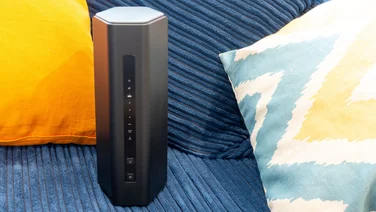To help us provide you with free impartial advice, we may earn a commission if you buy through links on our site. Learn more

- AX1600 spec
- Compact and unobtrusive
- Decent speeds and range in some scenarios
- High-performance routers and mesh networks can be faster
- Setup issues
While Wi-Fi 6 devices and routers are now commonplace, Wi-Fi 6 range extenders are another story. We’ve seen the RE505X from TP-Link and a Powerline kit from Devolo but there’s not an awful lot of competition out there. Perhaps this reflects the popularity of Mesh kits or the fact that Wi-Fi 6 routers have a lot of reach already but the Netgear EAX12 is a member of a fairly rare breed.
READ NEXT: The best Wi-Fi extenders to buy right now
Netgear EAX12 Range Extender review: What do you get for the money?
The EAX12 is a dual-band, four-stream Wi-Fi 6 extender with a slightly unusual AX1600 spec. Most low-end Wi-Fi 6 products we’ve seen are AX1800, with a maximum connection speed of 600Mbits/sec over the 2.4GHz band and 1,200Mbits/sec over the 5GHz band. The TP-Link RE505X was an AX1500 device, with 300Mbits/sec and 1,200Mbits/sec. The Netgear EAX12 comes somewhere in-between, with 400Mbits/sec over 2.4GHz and 1,200Mbits/sec on the faster, less congested band.
This arguably makes the EAX12 a better partner to AX1800 and faster routers, and it can work as part of a mesh system when used with Netgear’s own RAX-series Wi-Fi 6 routers. As an extender, it’s perfectly happy working with kit from other manufacturers.

It’s a neat device that plugs directly into a wall socket, with two internal antennas, four LED indicators and a single gigabit Ethernet port. It’s a lot less bulky than Devolo’s Powerline units, and a little more discreet than the RE505X, which has two chunky antennas sticking up at either side.
Netgear EAX12 Range Extender review: How easy is it to set up?
For set up, all you need to do is plug the EAX12 into the socket, connect your smartphone’s Wi-Fi to the extender’s internal Wi-FI network, then run Netgear’s Nighthawk Wi-FI app. Add the new device through this and the routine will take you through selecting your router’s SSID for both the 2.4GHz and 5GHz bands and entering the relevant passwords.
After that it sets up the extender on your network and does its best to create an optimal connection. You can set up separate SSIDs and passwords if you wish but most users will want the EAX12 to form part of a single network with the same credentials.

In my experience, the app didn’t work as well as it should have, though, partly because it refused to acknowledge the WPA2 password for my router. This is not unusually long or complex and – through years of testing laptops and various bits of network kit – I know it off by heart. However, the browser-based admin panel on the extender did accept it, so I was able to get the EAX12 up and running without having to change my password. This doesn’t appear to be a common issue but it caused some frustration while I worked through it.
With the connection made you can then try out the EAX12 in different locations, using the Router Link and Client Link LEDs to work out the optimal position. These glow green when the extender has a good connection, amber when it’s okay and red when it’s poor. The Nighthawk app also has features for checking the current status, viewing which client devices are connected and which band they’re connected to, with IP and Mac addresses and the current link rate available at a tap. Most of the time, though, it’s a question of set it and forget it. You can put the extender into place and let it do its stuff.
READ NEXT: Our guide to the best wireless extenders to buy
Netgear EAX12 Range Extender review: How well does it work?
The value of a range extender lies in getting Wi-Fi to areas of the house that your router can’t reach on its own and, here, the EAX12 does a reasonably good job. Testing with data transfers from a NAS connected to the router, my usual setup, based around a Netgear Orbi Wi-Fi 6 AX1800 Mesh system, gave transfer speeds of 16.23MB/sec (download) and 12.97MB/sec (upload) in the kitchen diner on the opposite side of our 1950s detached house. With the Orbi system’s router operating on its own, those speeds fall to 8.08MB/sec and 7.35MB/sec. With the EAX12, however, they go up to 22.04Mbits/sec and 16.16MB/sec. Not a bad result, and better than the Orbi system.
However, in the equally challenging office upstairs, the Orbi Wi-Fi 6 delivers connection speeds of 32.17MB/sec and 21.29MB/sec; an improvement on the 25.75MB/sec and 16MB/sec I get from the router unit solo. Switching to the EAX12, speeds increase to 21.47MB/sec and 7.54MB/sec. That’s reasonable but not as fast as the Orbi.

I also tried the extender with a second router: a Netgear RAX50 with AX5400 speeds. This pairing saw speeds in the office rise to 27.33MB/sec and 15.15MB/sec. The only problem? The router on its own provided speeds of 32.63MB/sec and 26.73MB/sec, which rather made the extender seem pointless.
What’s more, this combo wasn’t as speedy as the TP-Link RE505X paired with TP-Link’s AX90 router. This setup gave me speeds of 36.46MB/sec and 12.93MB/sec in the kitchen diner and 50.67MB/sec and 31.65MB/sec in the office.
On the plus side, extended testing over a week found the EAX12 solid and reliable, with no connection drop outs or noticeable variations in speed, which is something I’ve experienced with other extenders or mesh kits. It also held up well with more extreme applications like game streaming from PS5 to smartphone. It might not be the fastest extender, then, but it’s far from the flakiest.
READ NEXT: Our guide to the best wireless extenders to buy
Netgear EAX12 Range Extender review: Should you buy it?
Possibly. The big issue with Wi-Fi 6 range extenders – as it was with the TP-Link RE505X – is that, in some cases, you might get faster performance from a good Wi-Fi 6 router working on its own, especially as speedy units are becoming more affordable. Meanwhile, a decent mesh system will often get you better all-round coverage.
The extender wins, however, when you need to get Wi-Fi to a specific, hard to reach area of the house and you can find the optimal location in-between. If that’s what you need, then the Netgear EAX12 is a solid option, although the TP-Link RE505X has a slight edge on performance, price and overall ease-of-use.







